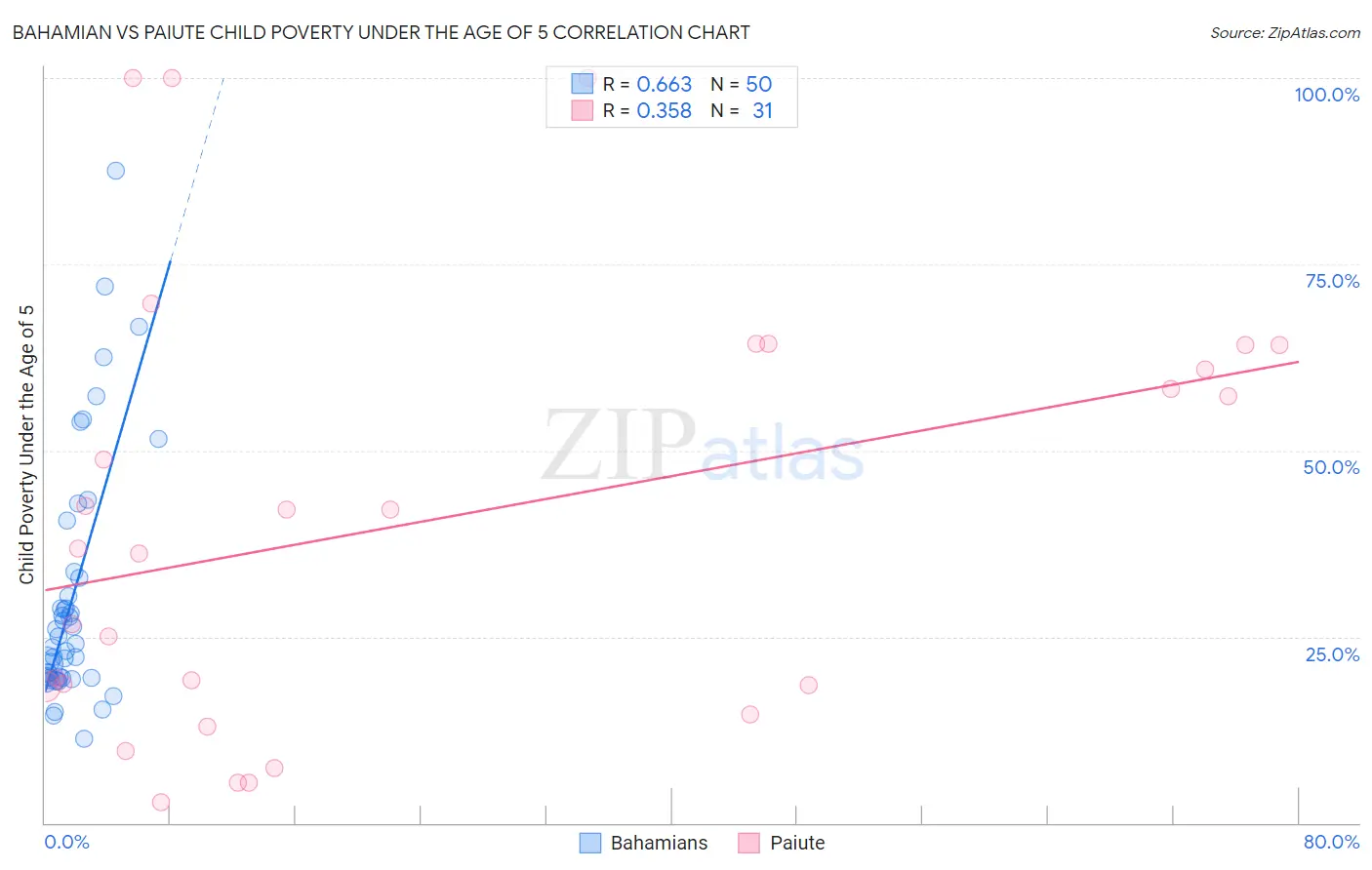Bahamian vs Paiute Child Poverty Under the Age of 5
COMPARE
Bahamian
Paiute
Child Poverty Under the Age of 5
Child Poverty Under the Age of 5 Comparison
Bahamians
Paiute
23.0%
CHILD POVERTY UNDER THE AGE OF 5
0.0/ 100
METRIC RATING
313th/ 347
METRIC RANK
23.8%
CHILD POVERTY UNDER THE AGE OF 5
0.0/ 100
METRIC RATING
324th/ 347
METRIC RANK
Bahamian vs Paiute Child Poverty Under the Age of 5 Correlation Chart
The statistical analysis conducted on geographies consisting of 111,326,474 people shows a significant positive correlation between the proportion of Bahamians and poverty level among children under the age of 5 in the United States with a correlation coefficient (R) of 0.663 and weighted average of 23.0%. Similarly, the statistical analysis conducted on geographies consisting of 58,012,157 people shows a mild positive correlation between the proportion of Paiute and poverty level among children under the age of 5 in the United States with a correlation coefficient (R) of 0.358 and weighted average of 23.8%, a difference of 3.7%.

Child Poverty Under the Age of 5 Correlation Summary
| Measurement | Bahamian | Paiute |
| Minimum | 11.3% | 2.7% |
| Maximum | 87.5% | 100.0% |
| Range | 76.2% | 97.3% |
| Mean | 30.2% | 40.5% |
| Median | 23.8% | 36.7% |
| Interquartile 25% (IQ1) | 19.5% | 18.4% |
| Interquartile 75% (IQ3) | 32.9% | 64.1% |
| Interquartile Range (IQR) | 13.4% | 45.7% |
| Standard Deviation (Sample) | 16.6% | 28.9% |
| Standard Deviation (Population) | 16.4% | 28.4% |
Demographics Similar to Bahamians and Paiute by Child Poverty Under the Age of 5
In terms of child poverty under the age of 5, the demographic groups most similar to Bahamians are Honduran (23.0%, a difference of 0.050%), U.S. Virgin Islander (23.0%, a difference of 0.090%), Seminole (22.8%, a difference of 0.65%), Arapaho (23.1%, a difference of 0.65%), and African (22.8%, a difference of 0.69%). Similarly, the demographic groups most similar to Paiute are Immigrants from Congo (23.9%, a difference of 0.21%), Central American Indian (23.9%, a difference of 0.39%), Pueblo (23.7%, a difference of 0.61%), Dominican (24.0%, a difference of 0.85%), and Immigrants from Dominican Republic (24.1%, a difference of 0.94%).
| Demographics | Rating | Rank | Child Poverty Under the Age of 5 |
| Immigrants | Dominica | 0.0 /100 | #308 | Tragic 22.7% |
| Houma | 0.0 /100 | #309 | Tragic 22.7% |
| Africans | 0.0 /100 | #310 | Tragic 22.8% |
| Seminole | 0.0 /100 | #311 | Tragic 22.8% |
| Hondurans | 0.0 /100 | #312 | Tragic 23.0% |
| Bahamians | 0.0 /100 | #313 | Tragic 23.0% |
| U.S. Virgin Islanders | 0.0 /100 | #314 | Tragic 23.0% |
| Arapaho | 0.0 /100 | #315 | Tragic 23.1% |
| Yakama | 0.0 /100 | #316 | Tragic 23.1% |
| Menominee | 0.0 /100 | #317 | Tragic 23.3% |
| Dutch West Indians | 0.0 /100 | #318 | Tragic 23.3% |
| Chippewa | 0.0 /100 | #319 | Tragic 23.4% |
| Choctaw | 0.0 /100 | #320 | Tragic 23.5% |
| Immigrants | Honduras | 0.0 /100 | #321 | Tragic 23.5% |
| Ute | 0.0 /100 | #322 | Tragic 23.5% |
| Pueblo | 0.0 /100 | #323 | Tragic 23.7% |
| Paiute | 0.0 /100 | #324 | Tragic 23.8% |
| Immigrants | Congo | 0.0 /100 | #325 | Tragic 23.9% |
| Central American Indians | 0.0 /100 | #326 | Tragic 23.9% |
| Dominicans | 0.0 /100 | #327 | Tragic 24.0% |
| Immigrants | Dominican Republic | 0.0 /100 | #328 | Tragic 24.1% |